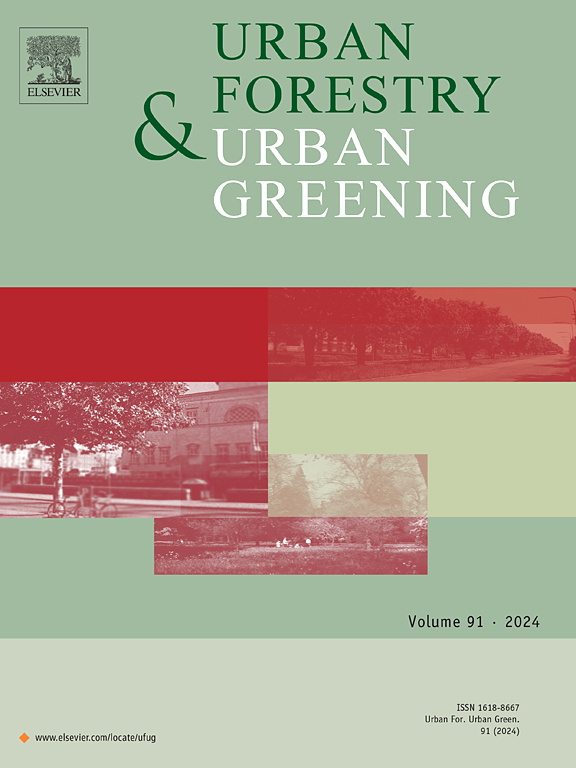Tapping the urban forest: Integrating tree canopy runoff (stemflow) into blue-green infrastructure
IF 6
2区 环境科学与生态学
Q1 ENVIRONMENTAL STUDIES
引用次数: 0
Abstract
As urbanization accelerates and climate change intensifies, cities increasingly turn to green infrastructure to manage stormwater and enhance resilience. Urban trees not only sequester carbon and reduce heat island effects but also partition rainfall into interception, throughfall, and stemflow. Stemflow (the water channeled down tree trunks) is often voluminous and nutrient-rich in urban settings, yet remains largely overlooked in conventional stormwater management. In this paper, we propose that repurposing stemflow can complement blue-green infrastructure by reducing runoff and providing supplemental irrigation for urban agriculture. We offer a brief review of stemflow’s contribution to the city surface, its nutrient composition (which often features elevated concentrations of nitrogen and potassium relative to open rainfall), and compare these values to runoff water and nutrient reduction targets. Using 1‑m resolution land cover data from EPA EnviroAtlas and a GIS-based methodology, we pair theory with a first-order feasibility assessment to identify “prime” canopy areas in four metropolitan regions: Philadelphia, Cleveland, Tampa, and Phoenix. Results indicate that prime canopy areas for stemflow capture, or diversion to other low impact development structures, range from 16.63 % in Philadelphia to 8.4 % in Phoenix, reflecting each city’s unique urban forestry and stormwater challenges. Ultimately, with minimal retrofits, stemflow harvesting appears to offer a low‑cost, scalable strategy that not only diverts runoff but also supplies valuable, nutrient‑rich water to urban gardens and infiltration systems. By integrating natural tree-canopy hydrology with established stormwater practices, cities might meaningfully reduce infrastructure burdens and advance sustainable water management.
开发城市森林:将树冠径流(茎流)整合到蓝绿色基础设施中
随着城市化的加速和气候变化的加剧,城市越来越多地转向绿色基础设施来管理雨水和增强抵御能力。城市树木不仅可以固碳和减少热岛效应,还可以将降雨分为截流、穿透流和茎流。在城市环境中,茎流(顺着树干流下的水)通常是大量且营养丰富的,但在传统的雨水管理中却很大程度上被忽视了。在本文中,我们提出重新利用茎流可以通过减少径流和为城市农业提供补充灌溉来补充蓝绿基础设施。我们简要回顾了stemflow对城市地表的贡献,其营养成分(通常以相对于露天降雨的氮和钾浓度升高为特征),并将这些值与径流水和营养减少目标进行了比较。利用来自EPA EnviroAtlas的1米分辨率土地覆盖数据和基于gis的方法,我们将理论与一阶可行性评估相结合,以确定费城、克利夫兰、坦帕和凤凰城四个大都市区的“主要”冠层区域。结果表明,用于茎流捕获或转移到其他低影响开发结构的主要冠层面积从费城的16.63 %到凤凰城的8.4 %不等,反映了每个城市独特的城市林业和雨水挑战。最终,通过最小的改造,茎流收集似乎提供了一种低成本、可扩展的策略,不仅可以转移径流,还可以为城市花园和渗透系统提供宝贵的、营养丰富的水。通过将自然树冠水文与已建立的雨水处理实践相结合,城市可能会有意义地减少基础设施负担,推进可持续的水资源管理。
本文章由计算机程序翻译,如有差异,请以英文原文为准。
求助全文
约1分钟内获得全文
求助全文
来源期刊

Urban Forestry & Urban Greening
FORESTRY-
CiteScore
11.70
自引率
12.50%
发文量
289
审稿时长
70 days
期刊介绍:
Urban Forestry and Urban Greening is a refereed, international journal aimed at presenting high-quality research with urban and peri-urban woody and non-woody vegetation and its use, planning, design, establishment and management as its main topics. Urban Forestry and Urban Greening concentrates on all tree-dominated (as joint together in the urban forest) as well as other green resources in and around urban areas, such as woodlands, public and private urban parks and gardens, urban nature areas, street tree and square plantations, botanical gardens and cemeteries.
The journal welcomes basic and applied research papers, as well as review papers and short communications. Contributions should focus on one or more of the following aspects:
-Form and functions of urban forests and other vegetation, including aspects of urban ecology.
-Policy-making, planning and design related to urban forests and other vegetation.
-Selection and establishment of tree resources and other vegetation for urban environments.
-Management of urban forests and other vegetation.
Original contributions of a high academic standard are invited from a wide range of disciplines and fields, including forestry, biology, horticulture, arboriculture, landscape ecology, pathology, soil science, hydrology, landscape architecture, landscape planning, urban planning and design, economics, sociology, environmental psychology, public health, and education.
 求助内容:
求助内容: 应助结果提醒方式:
应助结果提醒方式:


